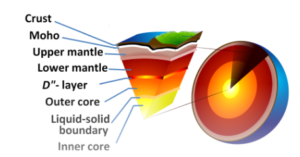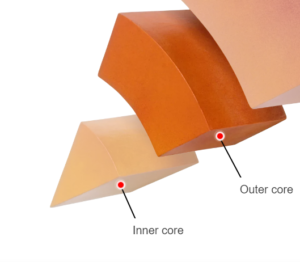The knowledge about the interior structure and composition of the earth has a long history. Before seismic tomography, scientists knew very little about the interior of the earth. The study of the passage of seismic waves through the earth has helped in knowing the structure of the earth’s interior and in defining the physical properties of various layers. The seismic waves travel at different velocities depending on the nature of the layer in which they are traveling. Thus they not only indicate the position of each layer but also give clues as to its composition.

The above figure shows the velocities of earthquake waves at various depths below the earth’s surface. The velocity curve shows sharp changes at various discontinuity surfaces. Based on seismic investigation, the earth can be divided into four major layers: (i) crust, (ii) mantle, (iii) outer core, and (iv) inner core.

1. Crust
The outer superficial layer of the earth is called the “crust”. It extends down to 30-40 kilometers beneath continents and 5-10 kilometers beneath ocean basins. At the bottom of the crust, the velocity of earthquake waves increases abruptly as they enter into a denser layer called “mantle”. The crust-mantel boundary is called “Mohorovicic discontinuity”. In the continental regions, the crust can be divided into two layers; the upper layer, which is less dense (sp. gr. 2.65), and granitic, is known as “sial”, while the lower layer, which is basaltic is denser with a specific gravity 3.0, is known as “Sima”. The term “sial” represents rocks rich in silica and alumina, and the term “sima” represents rocks containing silica and magnesia. Under the ocean only the “sima” layer is found, and the “sial” layer is absent.
Sial:
In earth science, the term sial refers to the composition of the upper layer of Earth’s crust, namely rocks rich in aluminium silicate minerals. It is sometimes equated with the continental crust because it is absent in the wide oceanic basins, but ‘sial’ is a geochemical term rather than a plate tectonic term. As these elements are less dense than the majority of Earth’s elements, they tend to be concentrated in the upper layer of the crust.
The uppermost layer of the crust is called the sial, consisting of silicate and aluminium (Si = silicate, Al = aluminium). On average, the thickness of the sial is 25 km from the surface. The continents are composed mainly of lighter rock material formed from silicon and aluminium, so the sial is thick over the continents and very thin or absent on the ocean floor, especially the Pacific Ocean. The average density of the sial is 2.7 gm/cc.
Geologists often refer to the rocks in this layer as felsic, because they contain high levels of feldspar, an aluminium silicate mineral series. However, the sial “actually has quite a diversity of rock types, including large amounts of basaltic rocks.”
The name ‘sial’ was taken from the first two letters of silica and of alumina. The sial is often contrasted to the ‘sima,’ the next lower layer on Earth, which is rich in silica and magnesium and is often exposed in the ocean basins; and the nickel-iron alloy core, sometimes referred to as the ‘Nife’. These geochemical divisions of Earth’s interior (with these names) were first proposed by Eduard Suess in the 19th century. This model of the outer layers of Earth has been confirmed by petrographic, gravimetric, and seismic evidence.
The sial has a lower density (2700–2800 kg/m3) than the sima, which is primarily due to increased amounts of aluminium, and decreased amounts of iron and magnesium. The base of the sial is not a strict boundary, the sial grades into the denser rocks of the sima. The Conrad discontinuity has been proposed as the boundary, but little is known about it, and it doesn’t seem to match the point of geochemical change. Instead, the boundary has been arbitrarily set at a mean density of 2800 kg/m3.
Because of the large pressures, over geologic time, the sima flows like a very viscous liquid, so, in a real sense, the sial floats on the sima, in isostatic equilibrium. Mountains extend down as well as up, much like icebergs on the ocean; so that on the continental plates, the sial runs between 5 km and 70 km deep.
Sima:
In earth sciences, sima is an antiquated blended term for the lower layer of Earth’s crust. This layer is made of rocks rich in magnesium silicate minerals. Typically, when the sima comes to the surface, it is basalt, so sometimes this layer is called the ‘ocean layer’ of the crust. The sima layer is also called the ‘basal crust’ or ‘basal layer’ because it is the lowest layer of the crust. Because the ocean floors are mainly sima, it is also sometimes called the ‘oceanic crust’.
The name ‘sima’ was taken from the first two letters of silica and of magnesia. Comparable is the name ‘sial’, which is the name for the upper layer of Earth’s crust (continental crust), namely rocks rich in aluminium silicate minerals.
The sima has a higher density (2800 to 3300 kg/m3) than the sial, which is due to larger amounts of iron and magnesium, and smaller amounts of aluminium. When the denser sima comes to the surface it forms mafic rocks, or rocks with mafic minerals. The most dense sima has less silica and forms ultramafic rocks.
2. Mantle
The mantle is located beneath the earth’s crust and has a thickness of about 2900 km. It has been divided into two layers: (i) the upper mantle, and (ii) the lower mantle. The boundary between these is at about 700 km depth. The average mineral composition of the upper mantle is similar to ultra-basic rocks like “peridotite” (sp. gr. 3.3). This zone provides lava for oceanic eruptions. In the lower mantle, the density of the material increases rapidly to 4.3 x 103 kg/m3. It has been suggested that the lower mantle consists of a mixture of peridotite and minerals of higher density.
The Upper mantle contains a most important zone called “asthenosphere”. It is located at depths between 50-100 km. In the asthenosphere, the velocity of S-waves decreases thereby indicating that this zone consists partly of melted rocks. Most basalts originate in this zone. It is believed that the plastic material of the asthenosphere moves and carries along the lithospheric plates. The outer solid portion of the earth existing above the asthenosphere is called the “lithosphere”. The lithosphere includes part of the upper mantle and crust.
Upper Mantle:
The upper mantle is a very thick layer of rocks, which is just beneath the earth’s crust. This layer is separated from the crust by “Mohorovicic boundary” or Mohorovicic Discontinuity”. It starts from 6 km on the ocean floor and 10 km on the continental surface. It is only 20% of the total thickness of the mantle. The thickness of the upper mantle is about 410 km.

The upper part of the upper mantle is mostly solid and hard. The upper mantle and crust are collectively called the Lithosphere. The lithosphere is the solid and hard part of the earth. The lower part of the upper mantle is mechanically weak and ductile. This region starts below 80-200 km from the earth’s surface and is known as the “asthenosphere”. Temperatures range from approximately 200 °C (392 °F) at the upper boundary near the crust to approximately 900 °C (1,650 °F) at the boundary with the lower mantle.
The upper mantle is composed of various elements and minerals. Among these, there are four most abundant elements in the upper mantle i.e. silicon, oxygen, magnesium, and iron. These elements are generally found in the form of mineral oxides, like silicon dioxide, magnesium oxide, and iron oxide.
Lower Mantle:
The lower mantle starts from 660 km and extends up to a depth of 2700 km. The lower mantle is hotter and denser than the upper mantle and is a transition zone. It is much more ductile than the upper mantle due to the higher temperature. The process of convection runs continuously, and this is the very reason the crustal plates keep moving. Most geologists agree about the structure of the lower mantle and think that subducted slabs of lithosphere have settled there, and heat transfers in the form of convection. Due to the process of convection, the crustal plates continuously move either apart, toward one another, or in a transverse direction.
The composition of the lower mantle is made up of Silicon and magnesium, which are a large part of the lower mantle. The most common compound is silicate perovskite, made up of magnesium, iron, silicon, and oxygen. The other common main component of the lower mantle is ferropericase, which is made of magnesium, iron, and oxygen.
3. Core
Beneath the Mantle, there is a central part of the earth known as the core and starts at 2900 km depth. The core is the hottest and densest part of the earth. It is further divided into two parts; the outer core and the inner core. Both the inner and outer core consist of mainly iron and nickel.

Outer Core:
The outer core is located just beneath the lower mantle (at a depth of 2900 km from the earth’s surface). The thickness of this layer is about 2200 km. It is a liquid part of the core and mainly consists of nickel and iron. It is responsible for the earth’s magnetic field. Iron inside the liquid outer core moves around as the earth spins on its axis. The liquid iron in the outer core is an excellent electrical conductor and due to motion, it creates the electrical currents that drive the magnetic field. The energy supply that drives convection in the outer core is provided as droplets of liquid iron freeze onto the solid inner core.
Inner Core:
The innermost part of the earth is in the form of a solid ball with a radius of 1220 km, which is known as the inner core. 20% of the earth’s radius is composed of the inner core. It is the hottest part of the earth with an estimated temperature of 5,430 °C and is believed to be hotter than the surface of the sun.
There are no samples of Earth’s core accessible for direct measurement, as there are for Earth’s mantle. Information about Earth’s core mostly comes from analysis of seismic waves and Earth’s magnetic field. The inner core is believed to be composed of an iron-nickel alloy with some other elements.
You may like to read:


Leave a Reply